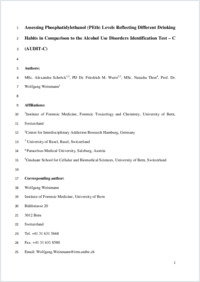Assessing phosphatidylethanol (PEth) levels reflecting different drinking habits in comparison to the alcohol use disorders identification test - C (AUDIT-C).
- Schröck A Institute of Forensic Medicine, Forensic Toxicology and Chemistry, University of Bern, Switzerland; Graduate School for Cellular and Biomedical Sciences, University of Bern, Switzerland.
- Wurst FM Center for Interdisciplinary Addiction Research Hamburg, Germany; University of Basel, Basel, Switzerland.
- Thon N Paracelsus Medical University, Salzburg, Austria.
- Weinmann W Institute of Forensic Medicine, Forensic Toxicology and Chemistry, University of Bern, Switzerland. Electronic address: Wolfgang.Weinmann@irm.unibe.ch.
- 2017-06-24
Published in:
- Drug and alcohol dependence. - 2017
Abstinence
Alcohol Use Disorders Identification Test – C (AUDIT-C)
Moderate drinking
Online-SPE-LC–MS/MS
Phosphatidylethanol (PEth)
Alcohol Drinking
Alcoholism
Biomarkers
Chromatography, Liquid
Ethanol
Female
Glycerophospholipids
Habits
Humans
Male
Self Report
Tandem Mass Spectrometry
English
In addition to monitoring problematic or harmful alcohol consumption, drinking experiments indicated the potential of phosphatidylethanols (PEth) in abstinence monitoring. To date, no profound evaluation of thresholds for the differentiation of abstinence from moderate drinking and for detection of excessive consumption based on PEth homologues exists. Investigations with a large group of healthy volunteers (n=300) were performed to establish PEth reference values reflecting different drinking habits. Blood samples were analyzed for PEth 16:0/18:1 and 16:0/18:2 by online-SPE-LC-MS/MS method. Results were compared to AUDIT-C questionnaires, to the amounts of alcohol consumed during the two-weeks prior to blood sampling, and were statistically evaluated. PEth concentrations were significantly correlated with self-reported alcohol consumption (r>0.69) and with AUDIT-C scores (r>0.65). 4.0% of 300 volunteers reported abstinence (AUDIT-C score: 0), no PEth was detectable in their blood. PEth 16:0/18:1 concentrations below the limit of detection of 10.0ng/mL match with abstinence and light drinking habits (≤10g pure alcohol/day). However, some volunteers classified as "excessive alcohol consumers" had negative PEth results. In the group of volunteers classified as "moderate drinkers" (AUDIT-C score: 1-3 (women) and 1-4 (men)), 95% of the test persons had PEth 16:0/18:1 ranging from not detected to 112ng/mL, and PEth 16:0/18:2 ranging from not detected to 67.0ng/mL. Combination of self-reported alcohol consumption and AUDIT-C score showed that negative PEth results match with abstinence or light drinking. Moderate alcohol consumption resulted in PEth 16:0/18:1 from 0 to 112ng/mL and for PEth 16:0/18:2 ranged from 0 to 67.0ng/mL. Higher PEth concentrations indicated excessive alcohol consumption.
- Language
-
- English
- Open access status
- green
- Identifiers
-
- DOI 10.1016/j.drugalcdep.2017.04.026
- PMID 28645063
- Persistent URL
- https://folia.unifr.ch/global/documents/292602
Statistics
Document views: 20
File downloads:
- fulltext.pdf: 0
